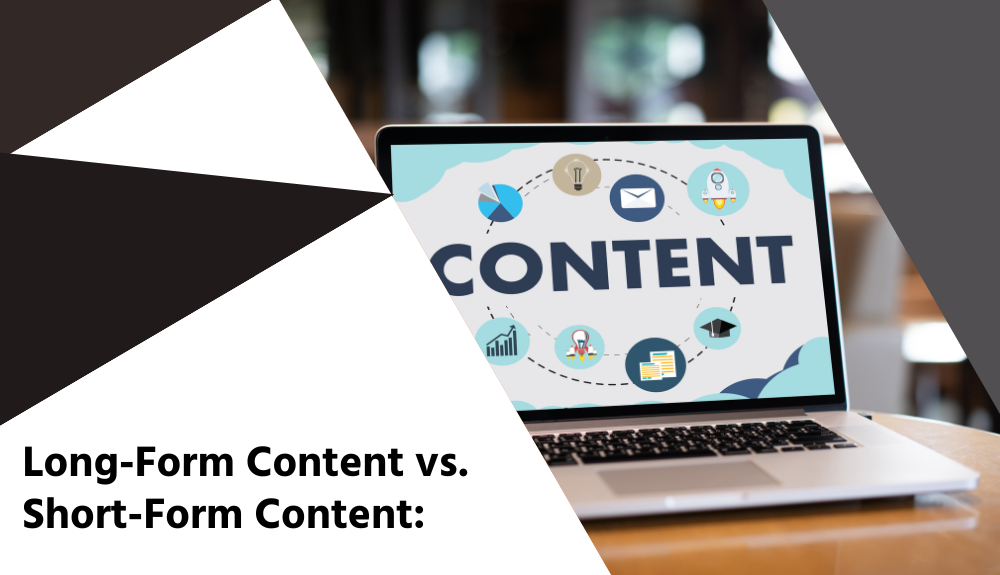Introduction to long-form and short-form content
Are you team Long-Form or team Short-Form when it comes to content creation? In the battle of word counts, both have their strengths and weaknesses. Whether you’re looking to boost your SEO game or cater to busy readers, understanding the pros and cons of long-form and short-form content is key. Let’s dive into the world of content creation and explore which format suits your needs best!
The benefits of long-form content:
Long-form content offers a myriad of benefits for content creators and readers alike. One significant advantage is its favorable impact on SEO rankings. Search engines tend to favor longer, comprehensive pieces that provide in-depth information on a topic, making it more likely to appear higher in search results.
Furthermore, long-form content allows writers to delve deep into a subject, providing valuable insights and detailed explanations that can enrich the reader’s knowledge and understanding. This depth helps establish the writer as an authority in their field, building trust with the audience over time.
By investing time and effort into crafting long-form content, creators showcase their expertise and dedication to delivering high-quality material. This commitment not only enhances credibility but also sets them apart from competitors who may opt for shorter, less informative pieces.
– Better for SEO
When it comes to content creation, one key advantage of long-form content is its effectiveness in boosting SEO. Search engines like Google tend to favor longer pieces of content as they provide more opportunities for relevant keywords and phrases to naturally appear throughout the text. This helps improve visibility and ranking on search engine results pages.
Longer articles also tend to attract more backlinks from other websites, which further enhances SEO performance. Backlinks are crucial for building domain authority and credibility in the eyes of search engines, ultimately leading to higher organic traffic.
Moreover, comprehensive long-form content allows writers to delve deep into a topic, covering various aspects thoroughly. This depth not only provides valuable information to readers but also signals expertise on the subject matter, reinforcing trust with the audience and search engines alike.
– Provides more value to readers
Long-form content has the advantage of providing more value to readers. When you delve deep into a topic, you can offer in-depth analysis, insights, and solutions that shorter pieces may not cover comprehensively. This allows readers to gain a thorough understanding and actionable takeaways from your content.
By offering detailed explanations and examples, long-form content equips readers with valuable information they can apply in real-life scenarios. Whether it’s a how-to guide or an informative article, the depth of long-form content ensures that readers walk away feeling informed and empowered.
Furthermore, longer articles have the space to address multiple facets of a subject matter, catering to various interests within your audience. This versatility adds value by accommodating diverse preferences and needs among your readership.
In essence, providing more value through long-form content is about going beyond surface-level discussions to offer meaningful insights and practical knowledge that enriches the reader experience.
– Establishes authority and expertise
Establishing authority and expertise through long-form content is essential in gaining trust and credibility with your audience. By delving deep into a topic, providing thorough insights, and showcasing your knowledge, you position yourself as an expert in the field. Readers are more likely to see you as a reliable source of information when you demonstrate a comprehensive understanding of the subject matter.
Long-form content allows you to showcase your expertise by offering detailed explanations, examples, and data to support your arguments. This in-depth approach not only educates readers but also instills confidence in your authority on the topic. It’s like having a conversation with someone who truly knows their stuff – it builds respect and admiration for your expertise.
When you consistently produce high-quality long-form content that showcases your authority on various subjects, you create a strong foundation for building relationships with your audience. People are drawn to experts who can provide valuable insights and guidance. In the competitive online landscape, establishing authority through long-form content sets you apart from the rest.
The drawbacks of long-form content:

Long-form content, while beneficial in many ways, does come with its own set of drawbacks. One of the main challenges is the amount of time and effort required to create comprehensive long articles. Researching, writing, editing, and formatting lengthy pieces can be a significant investment.
Moreover, not all topics or audiences are suited for long-form content. Some subjects may be better communicated in a more concise manner or may not warrant an extensive exploration. Long-form content also runs the risk of losing readers who prefer quick consumption or have shorter attention spans.
Additionally, maintaining reader engagement throughout a lengthy piece can be challenging. While depth is valuable in providing detailed information and analysis, some readers may find it overwhelming or lose interest before reaching the end of a long article.
– Requires more time and effort
When it comes to creating long-form content, one thing that can’t be ignored is the amount of time and effort it demands. Crafting a piece that is in-depth and comprehensive requires thorough research, planning, and execution. From conducting extensive research to structuring the content logically, every step takes time and dedication.
Moreover, ensuring the quality of each word and sentence in a lengthy article is no easy task. It involves multiple rounds of editing and proofreading to refine the content further. The process can be mentally taxing as you delve deep into the subject matter to provide valuable insights.
In addition to writing, incorporating visuals such as images or infographics also adds to the time investment needed for long-form content creation. Finding or creating relevant visual aids that complement the text takes additional effort but enhances reader engagement.
While producing long-form content may require more time and effort compared to shorter pieces, the end result often pays off in terms of providing substantial value to readers.
– May not be suitable for all topics or audiences
Long-form content, while valuable in many ways, may not always be the perfect fit for every topic or audience. Some subjects simply do not require a lengthy exploration to convey their message effectively. In cases where brevity is key, short-form content can deliver information quickly and efficiently.
Certain audiences might prefer concise and to-the-point content over in-depth articles that require a significant time commitment to read through. Tailoring your Content-Length and SEO to suit the preferences of your target audience is essential for engaging them effectively.
It’s important to consider the nature of the topic you are addressing when deciding between long-form and short-form content. While some subjects benefit from detailed explanations and comprehensive coverage, others can be adequately communicated in a more succinct manner.
Understanding your audience’s needs and preferences will help you determine whether long-form or short-form content is most appropriate for delivering your message successfully.
The benefits of short-form content:
Short-form content has its unique advantages that cater to the fast-paced digital world we live in. One benefit is its ability to grab attention quickly, making it ideal for audiences with shorter attention spans. In today’s busy society, where time is precious, short-form content allows readers to consume information efficiently without feeling overwhelmed.
Moreover, short-form content can be easily shared across various platforms and devices due to its concise nature. This makes it more likely to reach a wider audience and increase engagement levels. Whether it’s a catchy social media post or a brief blog article, short-form content lends itself well to the diverse online landscape.
Additionally, the brevity of short-form content encourages creativity in delivering key messages effectively. By focusing on the most essential points, writers can craft compelling narratives that resonate with readers on a deeper level. The power of succinct storytelling should not be underestimated in capturing interest and driving meaningful interactions online.
– Quick and easy to consume
Short-form content is like a quick snack for your brain – easy to consume and satisfying. In today’s fast-paced world, people are constantly on the go, looking for information that they can digest quickly. Short-form content fits perfectly into this lifestyle, offering bite-sized pieces of valuable insights without overwhelming the reader.
With short paragraphs and concise sentences, short-form content gets straight to the point without beating around the bush. This format is ideal for capturing attention in a busy online environment where distractions are just a click away. Readers appreciate the convenience of getting information rapidly without having to invest a lot of time or effort.
Whether it’s a social media post, a blog entry, or an infographic, short-form content excels at delivering key messages efficiently. Its brevity makes it easily shareable across various platforms, maximizing its reach and engagement potential. So next time you’re pressed for time but still crave quality content, remember that short-form pieces pack a punch in just a few words!
– Can cater to shorter attention spans
Short-form content has the advantage of catering to shorter attention spans in today’s fast-paced digital world. With people constantly bombarded by information, it’s vital to deliver content that can be quickly consumed and understood.
In a world where time is precious and distractions are plentiful, short-form content offers a convenient solution for those on the go. Whether it’s a quick social media post or a brief blog article, this type of content allows readers to get the gist without investing too much time.
By providing concise and to-the-point information, short-form content captures attention swiftly and holds it long enough to convey key messages. Its brevity doesn’t overwhelm readers but instead delivers information in bite-sized portions that are easy to digest.
For businesses looking to engage with audiences who have limited time or patience, short-form content can make a significant impact by delivering valuable insights in a compact format. It allows brands to connect with their audience efficiently while respecting their busy schedules.
The drawbacks of short-form content:

Short-form content, while quick to consume, comes with its own set of drawbacks. One major limitation is the lack of depth that can be provided in shorter pieces. Due to the concise nature of short-form content, there may not be enough room to explore complex topics or provide in-depth analysis.
Additionally, short-form content may struggle to establish credibility and authority on a subject compared to long-form pieces. This brevity can sometimes lead to oversimplification of information or ideas, potentially leaving readers wanting more substance.
Moreover, short-form content might not fully engage audiences who are seeking detailed insights or comprehensive explanations. It can be challenging to strike a balance between being brief and providing valuable information that resonates with readers on a deeper level.
In a world where attention spans are shrinking and information overload is prevalent, finding ways to deliver meaningful content in shorter formats without sacrificing quality is key for capturing audience interest effectively.
– Limited depth
Whether you choose long-form or short-form content for your website, both have their advantages and limitations. Long-form content is excellent for boosting SEO, delivering value to readers, and establishing expertise. However, it requires more time and may not suit all topics or audiences.
On the other hand, short-form content is quick to consume and can cater to shorter attention spans. Nevertheless, its limited depth might not be sufficient for complex subjects that require in-depth exploration.
The best approach is a mix of both types of content based on your goals and audience preferences. By balancing the benefits of long-form with the accessibility of short-form, you can create a well-rounded content strategy that engages your audience effectively while also enhancing your site’s visibility and authority in search engine rankings.












